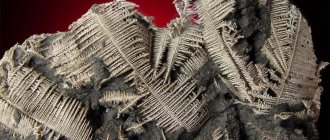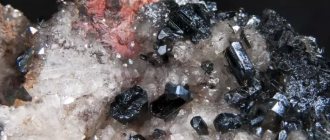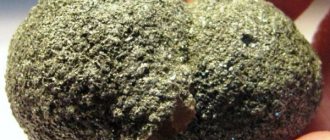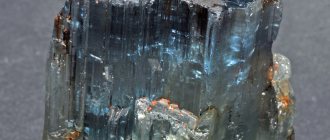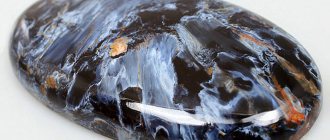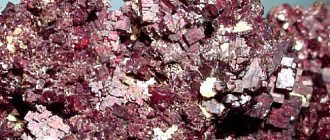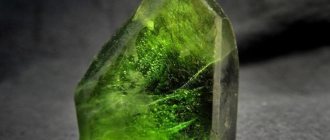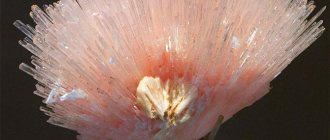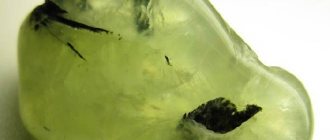One of the most ancient representatives of the world of stones is the mineral Molybdenite. It is also called “Molybdenum luster”, “Molybdenum pyrite” or “Eutome luster”. They knew about it in ancient times, and its descriptions can be found in ancient and medieval writings. It comes from the word "molybdenum", although this name at one time included galena as well as graphite.
origin of name
The name comes from the Greek molybdos - lead, as this name originally referred to substances containing lead. Later, graphite and molybdenite were combined under this name, the difference between which was established in 1778 by Scheele. Later, the name molybdenite began to be used in the same meaning as at present (Bronjar, 1807).
Molybdenite
Chemical composition
Chemical theoretical composition: Mo - 59.94; S - 40.06. Most chemical analyzes give almost exactly the theoretical ratio of Mo to S, indicating greater purity of the mineral. Characteristically, Re is present in the form of an isomorphic impurity in amounts up to 0.33%. Molybdenites of deposits in the central part of Kazakhstan contain from 1 * 10-4 to 5.6 * 10-4 Re; There is less rhenium in molybdenites of skarns, high- and medium-temperature molybdenum and molybdenum-tungsten deposits than in molybdenites of relatively low-temperature copper-molybdenum deposits.
Crystallographic characteristics
The system is hexagonal.
Symmetry class. Dihexagonal-bipyramidal. Axle ratio. s/a = 3.899.
Crystal structure
The crystal lattice is layered. The layers are located parallel (0001), and therefore the cleavage is very perfect. Flat crystal lattice networks formed by molybdenum ions are located between two layers of sulfur ions, parallel to the basal plane. Characteristically, Mo is surrounded by six S atoms at the vertices of a trigonal prism with distances Mo—S = 2.35 A. Anomalous electron diffraction was observed, indicating the polarity of the c axis.
Therapeutic effect
The mineral is present in multivitamin pharmaceutical preparations; it is necessary for the correct development of the body. Dairy products, liver, and baked goods are rich in it.
Lithotherapists use the properties of molybdenite in the following cases:
- Prevention of eye diseases: contemplate the mineral for 5-10 minutes daily.
- Normalization of blood pressure, gastrointestinal function, cardiovascular system, strengthening the immune system.
- Protection against seasonal viral diseases.
- Reducing migraines, headaches, joint pain.
- Relieving spasms and muscle tension after physical activity.
- Improving sleep quality (a sample of bluish hues is placed under the pillow).
Caution is required when using unprocessed crystals. Molybdenite dust is an allergen that causes irritation of the respiratory tract.
Form of being in nature
The appearance of crystals.
Crystals are hexagonal in shape, tabular according to (0001), less often - short-prismatic barrel-shaped. Prismatic and pyramidal faces are horizontally expanded, (0001) is often covered with a pattern of strokes parallel to the edge with (1011). Parallel intergrowths along (0001) are known, causing the step-like appearance of crystals.
Twins at (0001) were noted.
Aggregates. Leafy and scaly aggregates; often finely dispersed (visible only under a microscope) in quartz. Spherulite-like formations are often encountered.
Coarse scaly discharge
Physical properties
Optical
- The color is bluish-gray.
- The line is grey, the crushed line takes on an onion-green color (the graphite line remains grey).
- Metallic shine.
- Transparency Opaque.
Mechanical
- Hardness 1.
- Density 4.7—4.8
- Cleavage according to (0001) is very perfect. Prism cleavage is also indicated.
- Kink. The mineral is not brittle, flexible, but elastic. Flexible, but not elastic.
Feels greasy.
Stone care
It is necessary to realize that significant softness and fragility can play a cruel joke on Molybdenite if it is treated incorrectly. It is strictly forbidden to keep it together with other precious stones. Try to buy a separate box for it. Moreover, the base in it should be soft. The mineral is not afraid of particularly bright light, but you should not choose a place for it in direct sunlight. There is also no need to keep it in a room with excessive humidity.
And you should immediately stop using abrasive substances to clean it if you want to keep your talisman intact.
Chemical properties
Completely soluble in hot aqua regia. HNO3 oxidizes M0S2 to MoO3. When a sulfate solution of molybdenite is evaporated until SO3 vapor appears, a blue spot is formed. The decomposition of molybdenite can occur in both acidic and alkaline environments. Partially dissolves when exposed to alkaline bicarbonate solutions. In polished sections from standard reagents, only HNO3 has a weak effect. Difficult to decompose in concentrated sulfuric acid when boiled slowly.
Other properties
The electrical conductivity along (0001) is 103 times greater than along the c axis; increases with increasing temperature. The photoelectric effect was observed. Characterized by strong magnetic anisotropy. Molar magnetic susceptibility at room temperature.
When heated to 1350°, it partially dissociates, releasing S. At 1650–1700°, it melts with decomposition. When heated in air within 400-600°C, it is directly oxidized to MoO3, bypassing the stage of MoO2 formation.
Molybdenite.
Molybdenite is an industrially important mineral; main source of molybdenum and rhenium. In ancient times it was not distinguished from galena, the main mineral of lead. Hence the origin of the term (Greek “molybdos” - lead). The new metal in molybdenite was first discovered by the Swedish chemist K.V. Scheele (Carl Wilhelm Scheele) in 1778. Until then, molybdenum was also called another native mineral, graphite, which was similar in appearance to molybdenite and galena. Synonym: molybdenum shine.
Composition: molybdenum sulfide (MoS2). Syngony: hexagonal. Characteristic impurities: rhenium, selenium. Color: dark gray, sometimes with a bluish tint. It is opaque, but very thin plates are translucent. It has pronounced pleochroism.
You can write on paper with molybdenite just like a regular graphite pencil. The streak is bluish-gray, sometimes with a greenish tint. By its color, molybdenite is also easy to distinguish from graphite (everyone knows that graphite has an almost black streak). In addition, molybdenum sulfide is much heavier.
Very soft; hardness: 1 - 1.5. It can easily be ground into powder with your fingers, which, unlike graphite crushed into dust, has a characteristic metallic luster. Specific gravity - 4.7 g/cm3). Oily to the touch.
Does not melt under the blowpipe; colors the flame yellowish-green. Dissolves in nitric acid, releasing a grayish-white precipitate. Completely soluble in aqua regia.
Usually found in the form of solid scaly and leafy masses and inclusions. Occasionally, lamellar or short-stemmed crystals are found, having a hexagonal cross-section. Rare molybdenite crystals are prized by collectors. As a rule, they are incomplete and do not differ in perfect form. Due to its extreme softness, it is advisable to handle specimens of this mineral very carefully.
Molybdenite; Prov. Ontario, Canada. © Milton Speckels
Molybdenite is formed in the final stages of magma crystallization at temperatures and pressures higher than the critical point of water (374.5 ° C and 218 atm), at which the difference between liquid water and steam disappears, since there is no longer boiling or evaporation. Such processes, as well as the deposits of minerals formed during them, are called pneumatolitic.
It is found in skarns, deep rocks of igneous origin (granites, nepheline syenites). In high-temperature quartz veins it often occurs together with wolframite and cassiterite. The product of chemical changes is powellite. Other associated minerals: apatite, calcite, pyrite, chalcopyrite, magnetite, sphalerite. Molybdenite impurities give black color to some varieties of scheelite.
Molybdenite on quartz; Salt Lake County, Utah, USA. © Wendell Wilson
In Russia, molybdenite is mined in Khakassia (Sorskoye deposit, Sayany), Chita region (Zhirekenskoye), Buryatia (Orekitkanskoye). In the North Caucasus (Kabardino-Balkaria) there is the richest Tyrnyauz tungsten-molybdenum deposit. The largest deposits of molybdenite ores are located in China, Greenland, the USA (Colorado), Canada (Ontario), Mexico, Peru, and Chile. The best collectible crystals up to 20 cm in size are found in Central Japan (Gifu Avenue), on the island of Madagascar, in Namibia.
Molybdenite contains more than 60% molybdenum and is one of its main industrial sources. This metal has a high melting point (2620°C) and a very low coefficient of thermal expansion. Molybdenum and its compounds are used to alloy steels and are part of high-strength alloys widely used in the automotive industry, in the manufacture of boilers and turbines, and in the aerospace industry.
It is known that back in the 14th century in Japan, steel used in the manufacture of bladed weapons was alloyed with molybdenum. Since the First World War, it has been used to produce gun barrels and armor-piercing shells. Molybdenum salts are used as agricultural fertilizers. The mineral molybdenite is currently being studied as an alternative to silicon in semiconductor circuits.
In addition, molybdenite is the most important and practically the only cost-effective raw material for the production of rhenium, one of the rarest and most trace elements in the earth’s crust. In terms of melting point (3180°C), rhenium is second only to tungsten. Some properties of this metal can be called unique. For example, it does not lose its strength even after repeated heating and cooling. Probably, a rhenium filament filament would make the light bulb practically eternal.
Large accumulations of this element are extremely rare in nature. In 1992, a unique rhenium deposit was discovered on the Kuril Islands (Iturup). Here it is represented by a very rare mineral - rhenite (ReS2). Outwardly, it is very similar to molybdenite, for which it was originally mistaken.
By the way, the cost of 1 kg of pure rhenium on the world market reaches $10,000, and its reserves only in a small deposit on the slopes of the Kudryavy volcano, according to experts, amount to about 15 tons. And who knows what else the Kuril Islands store in their depths. But why does Russia even need these windswept bare rocks in the Pacific Ocean, called the Kuril Islands? Let's give them to Japan.
Diagnostic signs
Similar minerals . Graphite.
It differs from graphite in its lighter bluish-gray feature and in that when a drop of copper sulfate acts on a grain of zinc placed on molybdenite, no copper is released. In reflected light in polished sections, it is easily distinguished by its exceptionally strong bi-reflection and anisotropy, low hardness and higher reflectivity compared to graphite.
Satellites. Quartz, tourmaline, cassiterite, wolframite, fluorite, apatite, pyrite, beryl, potassium feldspars, micas, ilmenorutile, rutile, bismuthin.
Association with calcite
Where and how it is used
Molybdenite has found application among industrialists and collectors of mineral collections.
Industry
For the industrial complex, the mineral is a source of molybdenum, which is used in many ways:
- This is an additive for alloying steel.
- Material for mechanical engineering, including the space industry and aircraft construction.
- Premium semiconductor.
- Component of paints, varnishes, light bulbs, heating elements, lithium batteries, thermogenerators.
- Plant additive that stimulates growth and kills weeds.
The mineral is important as a source of rare earth rhenium.
Other areas
The ultra-soft molybdenite stone is not in demand by jewelers; decorators create esoteric products individually.
It is loved by collectors of mineralogical collections. Their goal is samples of different configurations and compositions from all deposits of the planet.
Place of Birth
The most common mineral is molybdenum, but rarely forms large aggregates. Genetically related to acidic igneous rocks, mainly granites and granodiorites, in which it sometimes occurs as small disseminations. It is observed in small quantities in pegmatites. The main industrial deposits of molybdenite are hydrothermal - high-temperature and medium-temperature. A close paragenesis of molybdenite with quartz is characteristic.
In granite pegmatites it is deposited at a late stage, accompanied by wolframite, cassiterite, bismuthine, etc. It is found in the Emerald Mines (Sverdlovsk region), in pegmatites of the Stavanger region (Norway), in large quantities - in the Mos deposit (Canada), in cassiterite -molybdenite pegmatites of the Transvaal (South Africa), etc. Occasionally, small amounts are also observed in alkaline pegmatites (in the Khibiny and Ilmen Mountains in Russia). Companions of molybdenite in hydrothermal veins are pyrite, wolframite, beryl, potassium feldspars, micas, fluorite, sometimes tourmaline, cassiterite, ilmenorutile, rutile, bismuthine and other minerals. A number of deposits are characterized by quartz veins in which this mineral is the main ore mineral (Gutaiskoye in the Chita region, Umaltinskoye in the Khabarovsk Territory, Eastern Kounrad and Airshoku in Kazakhstan, Questa in New Mexico, USA, etc.). In many deposits in quartz veins, molybdenite is associated with wolframite (Belukha and Bukuka in the Chita region, Akchatau, North Kounrad and Karaoba in Kazakhstan, etc.) or with sulfides of copper, iron and zinc (Takeli group of deposits in Tajikistan, etc.) . In some molybdenum deposits, molybdenite is confined to a system of differently oriented veinlets, around which the host rocks are greisenized or less altered. Greisenization near ore-bearing veinlets is typical for stockwork molybdenum deposits in Kazakhstan (Janet et al.). In the largest molybdenum deposit, Climax (Colorado, USA), molybdenum-bearing quartz veinlets with very thin molybdenite deposits are observed among altered granites. In paragenesis with quartz, molybdenite occurs in scheelite-bearing skarns, where it is mainly confined to quartz veinlets (stockwork type) cutting across skarns (Tyrnyauz in Kabardino-Balkaria, Lyangar in Uzbekistan, Azegur in Morocco, etc.). Deposits associated with secondary quartzites are very typical for molybdenite. These include deposits such as disseminated copper-porphyry ores, in which molybdenite (often finely dispersed) is observed in association with pyrite and chalcopyrite Boshchekul in Kazakhstan, Dastakert, Agarak and Kajaran deposits in Armenia, Almalyk in Uzbekistan, Bingham in the state. Utah, China in pcs. New Mexico (USA), Cananea in Mexico, etc.). Peculiar colloform kidney-shaped aggregates of molybdenite in late quartz were discovered in the contact-metasomatic Shalym deposit (Kemerovo region).
The isolation of this mineral among sedimentary rocks of the Mansfeld deposits (Germany) and in the cuprous sandstones of the Udokan deposit (Chita region) is associated with low-temperature hydrothermal formations.
Where is it mined?
Hydrothermal-sedimentary origin did not affect the occurrence of the mineral.
Molybdenite deposits are rare and thin:
- Industrial-scale production has been established in China, Russia, Armenia, Canada, Chile, and South Africa.
- Tajikistan, Kazakhstan, Japan, the USA, Mexico, Peru, and Germany are gradually producing.
The second source of stone is meteorites.
Molybdenite from Australia
Crystal optical properties in thin preparations (sections)
In infrared rays, uniaxial (—), no - 4.336; ne= 2.03; no - ne = 2.3015. In polished sections it is grayish-white in reflected light. Reflectivity for Ro (in%): for green rays 36, for orange - 31.5, for red - 30.5, for Re 15.5, 18 and 15, respectively. Bi-reflection is strong: parallel to elongation (Ro) - white with pale lilac tint, perpendicular to elongation (Re) - yellowish. Highly anisotropic. With incompletely crossed nicols, it exhibits a dim color effect in yellowish and bluish tones.
